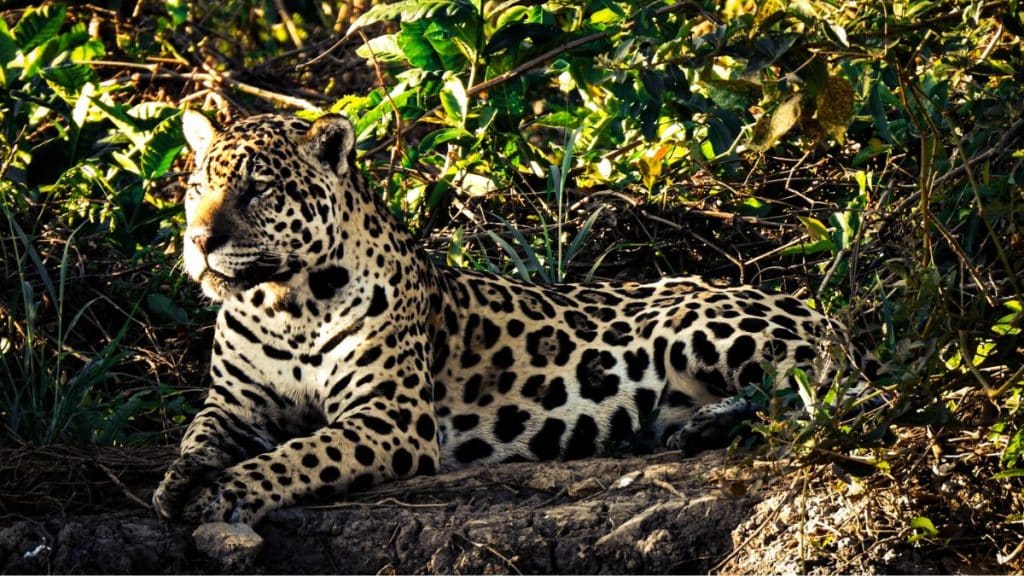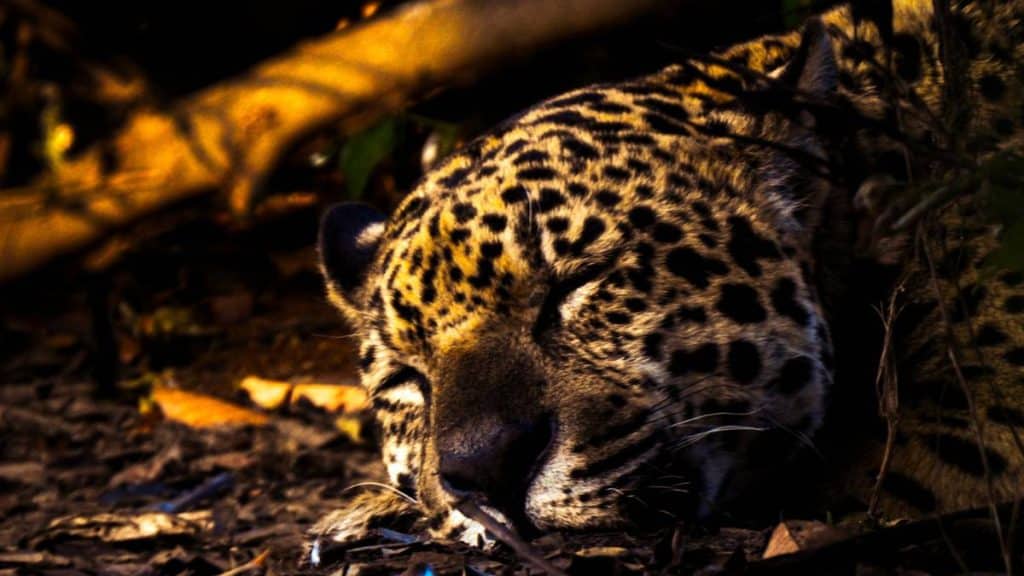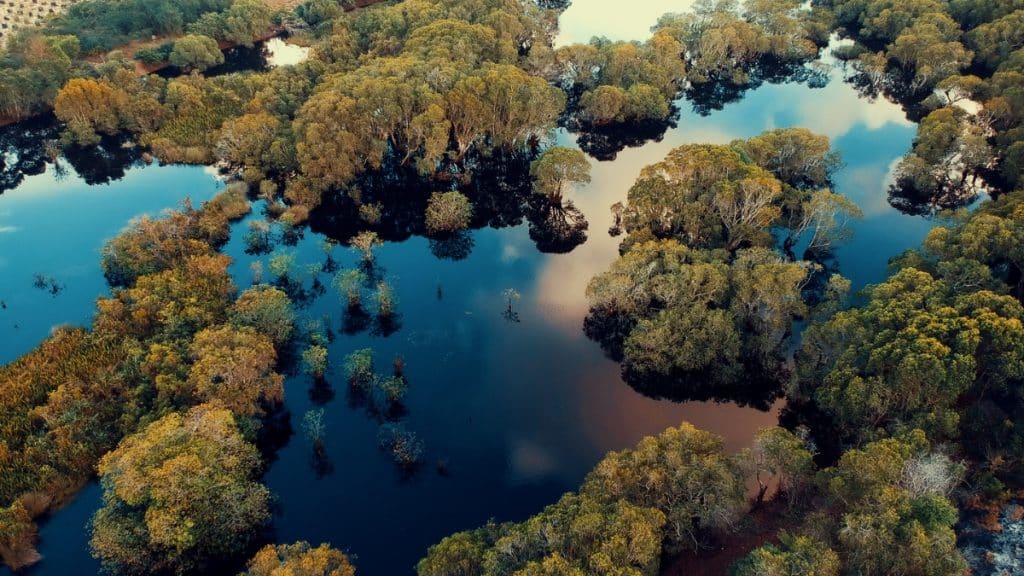A great beast stalks the forests, jungles, and wetlands of South America. It swims the rivers and climbs the trees. It stalks in the shadows. It explodes in attack with a leap that lands in a single, skull-cracking bite. It is the Jaguar, the magnificent king of the big cats of the Americas.
The Magnificent Jaguars
The Jaguar bows only to Africa’s lion and Asia’s tiger as the third largest feline on earth. For sheer power, however, the Jaguar has the greatest bite force of all the cats. Watch a jag leap from a high riverbank to land, jaws first, on a ten-foot caiman basking in the shallows below. The cat grabs the back of the croc’s head and sinks its two-inch fangs directly into the reptile’s brain, piercing its tough hide and crushing its thick skull. Before the first splash settles in the water, the caiman is dead and the cat is poised to drag its kill straight up that tall bank and into the undergrowth.
The Jaguar’s handsome coat provides perfect camouflage for stalking among the leaves and shadows. The cat’s fur has a yellow to reddish-orange base color with black facial spots that grow into rosettes on the body. Its facial markings are as unique as human fingerprints, allowing Jaguarland’s experts to identify each of the individuals who roam our neighborhood. We keep track of them in our “Jaguar Dossier.” Any guest who photographs a cat new to our dossier wins the right to name it.
Except for the time females spend with their cubs, the mighty Jaguar is a solitary creature. The male, weighing in at about 200 pounds, dominates a territory of roughly ten square miles. The smaller female’s territory is typically half that size and within its bounds she raises one or two cubs every year. She weans them at twelve weeks, but they remain in the birth den for an additional three months, depending on their mother to bring them food. Youngsters may stay near their mother for two years, learning how to be Jaguars. Their lifespan in the wild is about ten years.
As well as caiman, Jaguars prey on capybara, giant anteaters, peccaries, marsh deer and other mid-size animals. They also sometimes take calves and young heifers from local cattle ranches, incurring the wrath of their only enemy: man. At SouthWild, we have developed a program to pay ranchers for the loss of livestock to jags. We are the only eco-tourism company to offer this compensation, an arrangement that saves precious Jaguar lives every season. Although hunting jags is illegal in everywhere, there is still a black market for skins and body parts. The cat’s greatest threat, however, is habitat loss, which eats into its territory throughout its range. The world’s first protected area for Jaguar conservation was established in Belize in 1986. Since then, many Jaguar preserves have been created from the southern United States to Argentina. The species is listed as “Near Threatened” by the International Union for the Conservation of Nature.
Naturally, an apex predator of such beauty and power has claimed a place in the indigenous pantheon of animal gods. In most of the folklore, the Jaguar is both revered and feared. The ancient Mayans worshipped it as Balam, the god of the underworld, who ruled the realms of darkness, night, and the afterlife. In Aztec culture, warriors known for their skill and ferocity were thought to have taken on qualities of the Jaguar. Among many peoples, the great cat was also considered a protective spirit, watching over individuals, villages, and entire tribes. In some myths from the peoples of the Amazon rainforest, the Jaguar was a powerful incarnation of a great shaman, whose shape-shifting gift gave him access to the cat’s strength and stealth.
Throughout the millennia, indigenous peoples of Meso- and South America have shown their respect and reverence for the Jaguar by using its image in all their arts, such as murals and sculpture, and their many crafts, including pottery and textiles. Some surviving works portray the whole beast. Others incorporate patterns of spots and rosettes that are clearly shorthand references to the Jaguar persona, as well as tributes to its iconic beauty.
Jaguar Guaranteed
SouthWild invites you to visit us in Jaguarland, the heart of Brazil’s Pantanal, and get to know this magnificent feline. With our unique Jaguar Guarantee, we promise that you will have multiple audiences with this king of cats. The rooms we have waiting for you, in the very comfortable Jaguar Suites and the luxurious Jaguar Flotel, are anchored on the Piquiri River, whose banks are favorite corridors and hunting grounds for local jags. In Jaguarland, we host more than 200 known cats, wild animals so accustomed to our presence that they display all their fascinating behaviors just meters away from our boats. After a day spent in the company of the mighty cats, you will have the chance to learn more from the evening lecture by SouthWild’s resident Jaguar Biologist, a scientist carrying out his own field research. He loves to “talk Jaguar” and answer your questions.
For the photographers among you, the experience awaiting you at SouthWild’s 7,500-acre Jaguar Research Center is a dream. You will see big cats with an intimacy you’ve never thought possible. The Jaguars, who are always at the top of their game, challenge you to rase your photography to a new level, one equal to their supreme beauty and presence. Can you capture the essential Jaguar? You will never have a better opportunity. Don’t miss it!



